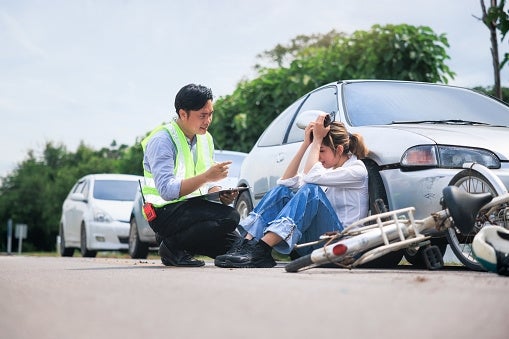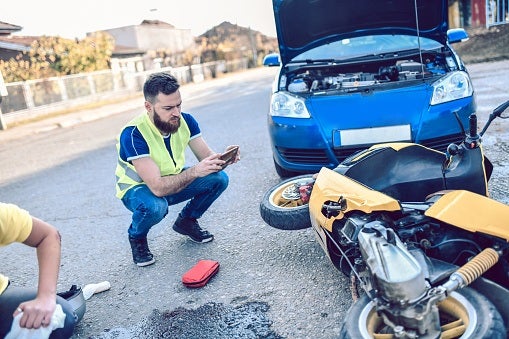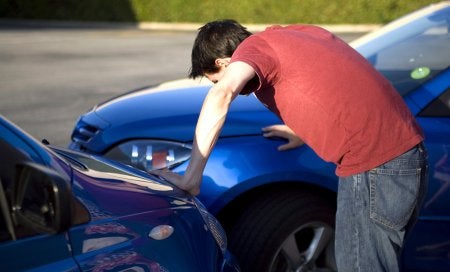-
How Is Fault Determined in a California Motorcycle Accident?
Riding a motorcycle on California’s scenic roads is a thrilling experience, but it also comes with risks. Motorcycle accidents can be devastating, and determining who’s at fault is the key to holding the right party responsible. Learn how fault is determined in motorcycle accidents, why these matters, and how a motorcycle accident lawyer can help.

Defining Fault
Establishing fault in a motorcycle accident means identifying which party is to blame, either by acting negligently or with malicious intent to cause harm. This important step declares who is financially responsible for damages and injuries. For accident victims, determining who’s at fault could make the difference between being fairly compensated and shouldering the burden of medical bills, motorcycle repairs, and other expenses.
In motorcycle accident cases, the blame could fall on several parties: the motorcyclist, another driver, or even a third party like a motorcycle manufacturer or government entity responsible for road maintenance. Because of this, determining fault isn’t always straightforward. That’s where having a solid understanding of the process—and possibly hiring a lawyer—comes into play.
Determining Fault in a Motorcycle Accident
Fault is determined by analyzing various pieces of evidence gathered from the crash scene. Here are the primary ways you can prove which party was at fault:
- Witness statements: Eyewitnesses can provide firsthand information on how the accident happened, including the actions of the motorcyclist and other drivers.
- Police report: The responding officer’s assessment of the scene and any citations they issue are prominent factors in determining fault. The police report is often a pivotal document in motorcycle accident cases.
- Photographic evidence: Pictures of the accident scene, vehicle damage, and injuries may prove invaluable. If possible, take photos right after the crash.
- Camera footage: In some cases, dashcams and cameras at intersections or mounted on buildings capture the accident, providing clear proof of exactly what happened and who was at fault.
- Expert testimony: Accident reconstruction specialists may be called upon to analyze the scene and give their expert opinion on how the accident occurred.
Remember, you should never discuss fault with the other driver or your insurance adjuster. Admitting fault, even informally, can come back to haunt you. Let your motorcycle accident attorney handle the details of fault with insurance companies and in court.

Comparative Negligence in California Motorcycle Accidents
California follows a comparative negligence rule, meaning fault can be shared between parties. Under this system, each party involved in the accident is assigned a percentage of the blame. Don’t worry—even if you are partially responsible for the accident, you can still recover damages, though your compensation will be reduced by your percentage of fault.
For example, imagine a motorcyclist is found to be 20% at fault for speeding, while the other driver is 80% at fault for making an illegal turn. In this scenario, the motorcyclist’s total compensation would be reduced by 20%.
Examples of Shared Faults in Motorcycle Accidents
- Speeding: If both the motorcyclist and the other driver were speeding, they may share fault.
- Improper lane changes: If the motorcyclist was speeding while the other driver made an unsafe lane change, both could share responsibility.
- Not using turn signals: If a motorcyclist fails to signal and a car turns without checking, both may bear some fault.
- Ignoring traffic lights: If a motorcyclist runs a red light as a car makes an illegal turn, they are both partly responsible.
- Unsafe lane splitting: California is the only state where lane splitting is legal. However, strict rules apply. If a motorcyclist travels more than 10 mph faster than the surrounding traffic, and nearby vehicles are traveling over 30 mph, such recklessness could make them partly to blame.
How a Motorcycle Accident Lawyer Can Help
Navigating a motorcycle accident case can be complicated. A skilled motorcycle accident lawyer will help you through every step of the process. First, they thoroughly investigate the accident, collecting evidence like police reports, witness statements, and expert opinions. They handle all communications with insurance companies, develop a solid legal strategy, and represent you in court if the insurance company won’t settle. Having a legal expert by your side ensures you won’t make mistakes that could reduce your compensation, like admitting fault or miscalculating the value of your claim.
Contact Our Motorcycle Accident Law Firm
If you have sustained motorcycle accident injuries in California, turn to Bakerink, McCusker & Belden. We have over 35 years of experience helping accident victims in Tracy, CA, and the San Joaquin County area. Our dedicated legal team has consistently ranked among the “Best of Tracy” and holds a prestigious Martindale-Hubbell® BV Distinguished® rating for our expertise and ethical standards. Contact us today for a free, no-obligation consultation so we can begin building your motorcycle accident case.
-
The Dos and Don’ts of Auto Accident Claims
The process of filing an auto accident claim isn’t always as straightforward as it might appear. Unfortunately, it’s all too easy to make a simple mistake that can compromise your ability to obtain just compensation for your losses. It’s best to contact a personal injury lawyer near Tracy or Manteca as quickly as possible. Your personal injury lawyer will offer invaluable legal guidance and help you get the funds you need to get your life back on track.

Do Make Some Prompt Phone Calls
After a car crash, your first phone call should be to a 911 dispatcher. After the police clear you to leave the scene, you should go to the nearest medical center. Once you’ve been evaluated by a doctor, it’s time to call a personal injury lawyer. It’s advisable to speak with an injury lawyer before you contact the insurance company because your lawyer can guide you through the process of speaking with the claims representative without inadvertently saying something that might lead to negative consequences.
Don’t Forget Documentation
Even in simple accident cases, the insurance carrier may try to shift some of the blame to the victim to lower the amount of the settlement. Physical evidence and eyewitness testimony will help prove your case. Bring all relevant documents to your meeting with your personal injury attorney, such as a copy of the police report, your medical records, and car insurance policy. Your lawyer will need information about the other driver and a list of witnesses, such as passengers or passersby. It’s always a good idea to take photographs of the crash site, the damage to the vehicles, and any other relevant details. Your lawyer will use all of this evidence when he or she negotiates with the insurance carrier on your behalf.
Don’t Sign a Waiver
When you speak with the claims representative, it’s important that you avoid giving any recorded statements. Do not provide the insurance company with any written statements, or sign any waivers or releases until you speak with your attorney about these matters.
RECENT POSTS
categories
- Uncategorized
- Personal Injury
- Estate Planning
- customer reviews
- Financial Planning
- Work Injury
- Tracy Lawyer
- Attorney
- Dog Bites
- Auto Accident
- Slip and Fall
- Car Accident
- Living Trusts
- Trust Administration
- Living Will
- Wrongful Death
- Probate
- advanced health care directive
- About Us
- Russian linguist
- Infographic
- Wills and Trusts
- Will
- Car Crash
- Executor
- Whiplash Injuries
- Estate Taxes
- Slip and Fall Injury
- Auto Accident Claims
- Intestate Succession
- Disinheritance
- Trust Administrators
- Cycle Accident
- Accident
